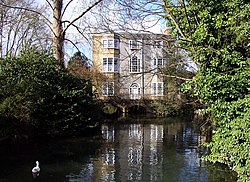Grandpont
| Grandpont | |
| Berkshire | |
|---|---|
 Grandpont House from the Isis towpath | |
| Location | |
| Grid reference: | SP510053 |
| Location: | 51°44’42"N, 1°15’47"W |
| Data | |
| Post town: | Oxford |
| Postcode: | OX1 |
| Dialling code: | 01865 |
| Local Government | |
| Council: | Oxford |
| Parliamentary constituency: |
Oxford West and Abingdon |
Grandpont is a mainly residential area in northern Berkshire forming a suburb of Oxford. It consists mainly of terraced late-Victorian and Edwardian houses.
It also contains the Grandpont Nature Park — a riverside park managed by Oxford City Council. The park covers 7½ acres and was created in 1985 on the site of a gas works that was demolished in 1960. The former railway bridge, used to carry coal from the main railway line across the River Thames to the older gas works in St Ebbes on the north bank, still stands, and is in use as a footbridge. A later bridge, Grandpont Bridge, provides a more direct pedestrian and cycle route across the river to St Ebbes.
History
The name of the area derives from the Grandpont, a mediæval stone causeway now known to survive within the core of the modern Abingdon Road for a distance of at least 700 yards south of the city centre.[1] The causeway may have been first built in the Anglo-Saxon era, and rebuilt in the late 11th century[2] by the first Norman lord of Oxford, Robert D'Oyly I, crossing the low-lying ground south of the town, still very liable to winter flooding from the nearby River Cherwell.
In 1279 there were 62 houses in Grandpont. The suburb grew slowly in the following centuries, and extensive development did not take place until the 19th century. In 1844 the Great Western Railway opened Oxford's first railway station in what is now Western Road, and that stimulated development.[3] One of the houses built there is Grandpont House named after the neighbourhood.[4] Built for Sir William Elias Taunton, the Town Clerk of the city of Oxford, in 1785, his family controlled the house until Brasenose College acquired the house in 1847.[4] Brasenose maintained the house until 1959 when it was purchased by the Netherhall Educational Association.[4]
The Church of England parish church of St Matthew, Grandpont was built in 1890,[5] presumably as a chapel of ease. It became a parish separate from St Aldate's in 1913.[3]
References
- ↑ "What lies beneath" — Annie Dodd, Oxford Today, 2004
- ↑ Crossley & Elrington, 1979, pages 284-295, section "Bridges"
- ↑ 3.0 3.1 Hibbert, 1988, s.v. Grandpont
- ↑ 4.0 4.1 4.2 "A historic house". 22 Mar 2014. http://www.grandpont-house.org/. Retrieved July 18, 2014.
- ↑ Sherwood & Pevsner, 1974, page 335
Sources
- Crossley, Alan; Elrington, C. R. (eds.); Eleanor Chance, Christina Colvin, Janet Cooper, C.J. Day, T.G. Hassall, Nesta Selwyn (1979). A History of the County of Oxford, Volume 4. Victoria County History.
- Hibbert, Christoper, ed. The Encyclopaedia of Oxford. London: Macmillan Publishers. ISBN 0-333-39917-X.